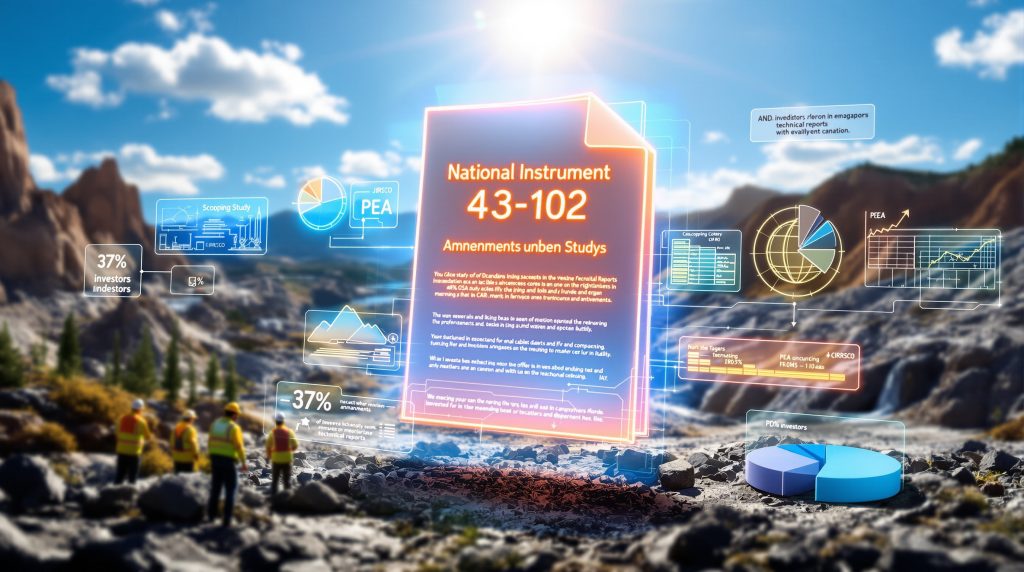National Instrument 43-101 Changes: What Mining Professionals Need to Know in 2025
National Instrument 43-101 (NI 43-101) has been the cornerstone of mining disclosure in Canada for nearly 25 years. As the global standard for mineral project disclosure, this regulatory framework ensures investors receive reliable, transparent information about mining projects. In 2025, significant National Instrument 43-101 changes are being implemented to modernize and streamline these requirements.
The Canadian Securities Administrators (CSA) have proposed amendments following extensive industry consultation, with the public comment period open until October 10, 2025. These changes aim to clarify existing requirements rather than add new regulatory burdens, focusing on making disclosures more effective for both issuers and investors.
According to Victoria Yehl of the BC Securities Commission, the regulatory approach focuses on being "guardrails on the highway" to keep companies compliant rather than punitive enforcement. This philosophy guides the modernization effort behind the 2025 amendments.
How Did the Regulatory Review Process Work?
Unlike previous updates that presented predetermined changes, the CSA took a consultation-first approach for the 2025 amendments. In 2022, they released a consultation paper with 38 questions derived from recurring issues identified during disclosure reviews.
This approach yielded 85 comment letters—an unprecedented response rate that provided valuable insights into industry practices and concerns. The CSA also conducted surveys at investor conferences including the Vancouver Resource Investment Conference (VRIC), surveying almost 700 respondents.
The survey revealed that approximately 36-37% of retail investors actually read technical reports when making investment decisions—a significantly higher percentage than the expected 10-15%. Furthermore, three-quarters of surveyed investors were aware that disclosure rules exist in securities law, demonstrating a higher level of investor engagement than previously assumed.
This evidence-based approach ensured the amendments would address genuine market needs while maintaining the core purpose of protecting investors. The CSA's focus on retail investors (described by Yehl as "mom and dad who invest their $3,000 in a mining company") has shaped amendments that benefit both sophisticated and casual investors.
What Are the Key Changes to NI 43-101?
Scoping Studies Replace Preliminary Economic Assessments
One of the most significant changes involves replacing the term "Preliminary Economic Assessment" (PEA) with "Scoping Study." This change aligns Canadian terminology with international reporting codes and addresses longstanding criticism that the PEA was defined by what it wasn't rather than what it was.
The Canadian Institute of Mining, Metallurgy and Petroleum (CIM), as the practice standard setter, has taken ownership of defining scoping studies to ensure greater alignment with CRIRSCO (Committee for Mineral Reserves International Reporting Standards) definitions. This change aims to reduce confusion and improve compliance in an area that has historically seen significant non-compliance.
Victoria Yehl explained that the PEA was "always criticized for being a non-definition definition in the rule" and was "defined as what it's not as opposed to what it is." This fundamental redefinition should provide clearer guidance for qualified persons and issuers.
Personal Inspection Requirements Updated
The amendments remove the "seasonal weather deferral" exception for personal inspections. This provision, originally created during Canada's Northwest Territories diamond rush in the early days of the regulations, allowed qualified persons to defer site visits due to weather conditions. According to Yehl, this provision was "rarely properly followed up with actual inspections once conditions improved."
The personal inspection requirement itself remains, as industry feedback overwhelmingly confirmed its critical importance. Yehl noted this received "the most significant response" during consultation, with responses "all aligned that the current personal inspection was a critical element." The regulations maintain a principles-based approach to unique circumstances, such as deep-sea mining projects where direct inspection of the resource may be impossible.
Enhanced Mineral Resource Disclosure Requirements
While not fundamentally changing the requirements, the amendments emphasize the importance of disclosing key parameters used in resource estimation, including:
- More detailed information about reasonable prospects for eventual economic extraction (RPEEE)
- Drill hole spacing used for different resource classification categories
- Clearer disclosure of classification methodologies
These clarifications aim to help investors better understand and compare resource estimates across different projects and companies. The CSA has observed that mineral resource estimation is often perceived as a "black box" by the public, and these disclosure enhancements seek to provide more transparency.
Adjacent Property Disclosure Clarified
The amendments strengthen requirements for cautionary statements when issuers discuss adjacent properties. This addresses situations where companies have leveraged neighboring mineralization without conducting meaningful work on their own properties.
Yehl provided a specific example where "a junior here collected samples on the edge of their claims and never really went onto their claims" while leveraging adjacent mineralization. The changes require clearer disclosure that adjacent property results are not necessarily indicative of the issuer's property, helping investors avoid misleading conclusions about project potential.
Data Verification Requirements Reinforced
Many qualified persons have incorrectly limited data verification to exploration and drilling activities. The amendments clarify that verification applies to all technical data used in disclosure, not just exploration results.
The changes emphasize that qualified persons must clearly describe the steps they personally took to verify data, rather than simply reporting verification work done by others. This reinforces the core principles of data verification trends while maintaining flexibility in how qualified persons approach this crucial task.
Royalty Company Exemptions
In a significant change for royalty and streaming companies, the amendments remove the requirement for these issuers to file technical reports. This acknowledges that royalty companies typically cannot access the data needed for verification or conduct personal inspections, making technical reports less valuable for investors in this context.
When this exemption was first created, there were only two or three royalty companies in the market. Today, with 30-50 such issuers, this change represents a significant reduction in regulatory burden without compromising investor protection.
How Will These Changes Impact the Mining Industry?
For Mining Companies
The amendments primarily streamline and clarify existing requirements rather than adding new regulatory burdens. Companies should expect:
- Clearer guidance on disclosure requirements
- Reduced ambiguity in technical report preparation
- Potential cost savings from eliminated unnecessary requirements
- More consistent application of standards across the industry
Victoria Yehl emphasized that technical reports should be "summary documents" rather than comprehensive data dumps, noting some reports reach "2,500 further pages of appendices, which was every piece of work ever done." The amendments reinforce this principle, encouraging more focused, relevant disclosure.
For Qualified Persons
Qualified persons will benefit from:
- More explicit guidance on what constitutes adequate data verification
- Clearer expectations for personal inspection requirements
- Better alignment with international standards and practices
- Reduced ambiguity in technical report preparation
The CSA's emphasis on building a "culture of compliance" rather than punitive enforcement should encourage qualified persons to seek guidance when needed. Yehl noted, "We answer our phones. If you call me, I will answer my phone," highlighting the regulator's collaborative approach.
For Investors
The changes aim to improve the quality and consistency of mining disclosure, helping investors by providing:
- More comparable information across different projects
- Better understanding of resource classification guide
- Clearer disclosure of key parameters and assumptions
- Improved transparency regarding adjacent property information
The goal is to help companies "tell your story on your mineral project very well under the disclosure rules" and "attract more investors" through better disclosure, ultimately supporting capital formation in the mining sector.
How Do These Changes Align with International Standards?
The amendments bring NI 43-101 into closer alignment with international reporting codes while maintaining Canada's position as a global leader in mining disclosure standards. Key alignment points include:
- Adopting "Scoping Study" terminology consistent with international usage
- Maintaining alignment with CRIRSCO definitions for mineral resources and reserves
- Recognizing the sufficiency of CIM definition standards without requiring reconciliation to foreign codes
However, some differences remain, such as maintaining the "Qualified Person" designation rather than adopting the "Competent Person" terminology used in codes like JORC (Australasian Joint Ore Reserves Committee). This designation has historical roots dating back to the 1970s national policies 2A and 22, with "the first technical report or engineering report actually filed in Ontario in the late 1950s."
The CSA staff maintain dialogue with international counterparts, with Yehl noting they "talk to our counterparts in Australia on occasion" and "talk to our counterparts at the SEC," suggesting potential for further alignment in the future.
When Will These Changes Take Effect?
While the public comment period closes on October 10, 2025, implementation is expected to take at least a year. This extended timeline gives mining companies, qualified persons, and investors adequate time to understand and adapt to the changes.
Victoria Yehl confirmed "these are not going to be enacted tomorrow" and there will be "lots of warning and time for people to adjust." The CSA has emphasized that these amendments represent evolution rather than revolution in mining disclosure requirements, focusing on clarification and modernization rather than fundamental changes to the disclosure regime.
The CSA employs 8 technical staff across Canada to oversee mining disclosure: 4 geologists in Vancouver, 2 geologists in Ontario, and 2 engineers plus 1 geologist in Quebec. This team will be responsible for implementing the changes and providing guidance during the transition period.
What Should Mining Professionals Do Now?
For Companies and Qualified Persons
-
Review the proposed amendments and consider submitting comments before the October 10 deadline
-
Begin evaluating current disclosure practices against the proposed changes
-
Identify areas where additional clarification may be needed
-
Consider participating in industry discussions and forums about the changes
The BC Securities Commission maintains an open-door policy with Yehl stating "We answer our phones. If you call me, I will answer my phone." The commission also "goes to the Roundup Conference here in Vancouver, we actually man a booth" for public engagement, providing opportunities for direct interaction with regulators.
For Investors
-
Understand how the changes will affect the information available for investment decisions
-
Recognize that technical reports will continue to be summary documents, not comprehensive data dumps
-
Look for improved disclosure of key parameters and assumptions in future technical reports
-
Take advantage of enhanced disclosure requirements to make more informed investment decisions about junior mining strategies
Conclusion
The 2025 amendments to National Instrument 43-101 represent a thoughtful modernization of Canada's mining disclosure regime based on extensive industry consultation and evidence-based decision-making. By clarifying requirements, removing outdated provisions, and enhancing guidance, these changes aim to improve the quality and consistency of mining disclosure while reducing unnecessary regulatory burden.
As the mining industry evolution continues, these National Instrument 43-101 changes ensure that NI 43-101 remains relevant, effective, and aligned with international best practices, ultimately benefiting both issuers and investors in the global mining sector.
Further Exploration
Readers interested in learning more about mining disclosure regulations can also explore related educational content, such as the Canadian Securities Administrators' consultation papers and proposed amendments to National Instrument 43-101. These resources offer additional perspectives on the evolution of mining disclosure standards in Canada and globally.
The CSA's investor education initiatives provide valuable insights for retail investors looking to better understand technical reports and interpreting drill results. Additionally, industry associations like the Canadian Institute of Mining, Metallurgy and Petroleum (CIM) offer resources that explain the technical aspects of resource estimation and classification.
For those interested in financial disclosure examples, Scorpio Mining's 2014 year-end financial results and Decklar Resources' Q1 2021 financial statements provide valuable context for understanding how mining companies report financial information alongside technical disclosures.
Want to Catch the Next Major Mining Discovery Before the Market?
Discovery Alert's proprietary Discovery IQ model provides instant, real-time notifications when significant mineral discoveries are announced on the ASX, giving traders and investors a crucial edge in capitalising on potentially transformative opportunities. Explore why major mineral discoveries can lead to exceptional returns by visiting the dedicated discoveries page.




